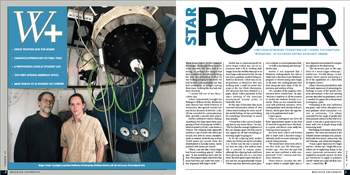Star Power
 When Roger Cohen ’03 first looked at the images, he thought there must be some mistake. The dates had to be wrong, or perhaps the images had been mislabeled. But after rechecking the data, the realization of what he was looking at began to take hold. He had located a young sunlike star that had undergone an eclipse lasting three years. Nothing like this had ever been observed.
When Roger Cohen ’03 first looked at the images, he thought there must be some mistake. The dates had to be wrong, or perhaps the images had been mislabeled. But after rechecking the data, the realization of what he was looking at began to take hold. He had located a young sunlike star that had undergone an eclipse lasting three years. Nothing like this had ever been observed.
“I nearly fell out of my chair,” Cohen says.
Cohen immediately brought his findings to William Herbst, Wesleyan’s John Monroe Van Vleck Professor of Astronomy, who gained renown last year for his discovery of KH15D—a faroff star encircled by a proto-planetary disk—possibly a nascent solar system.
Herbst confirmed Cohen’s finding: Something very large spent three years passing in front of a young star, HMW15, which is located in IC348, a star cluster in Perseus. The eclipsing body apparently moved at a rate of about 100 meters per second, very slow by cosmic standards. Earth, in contrast, circles the Sun at about 30,000 meters per second; Pluto, the slowest planet in our solar system, moves at about 4,000 meters per second.
“When I saw the data I knew Roger had found something special,” Herbst says. “It was something never seen before. The longest eclipse observed to this point had been just under two years. I was impressed with Roger’s work.”
Herbst was so impressed partly because Roger Cohen was not an astronomer with a Ph.D. working with images from the Hubble telescope or at some large earth-bound facility. He was not even a graduate student toiling toward his doctorate. Cohen was an undergraduate at Wesleyan who was working with a small 0.6-meter telescope at the Van Vleck Observatory. The discovery has been detailed in a paper, which Cohen presented at this year’s meeting of the American Astronomical Society (AAS) in Nashville, Tenn.
It’s the type of discovery that many seasoned astronomers dream of. But Cohen wasn’t looking for some out-of-this-world finding. He was just looking for something “interesting” in recent data samples.
“I found this in the course of analyzing data for my senior thesis,” he says. “The fact that the average brightness of this star changes quite a bit from year to year tipped me off that something interesting might be going on.”
As for the eclipsing body, neither Cohen nor Herbst can say for sure what it is. Herbst says the star is similar to our Sun but only a few million years old, a juvenile in cosmic terms. Although the eclipsing body could have been passing the star in a one-time event, the slow speed argues that the object and star are gravitationally bound. Cohen may have detected a proto-planet or a feature in a proto-planetary disk.
“It really is fascinating and exciting,” Herbst says.
Herbst is not surprised that a Wesleyan undergraduate was able to make such a discovery. Since Wesleyan’s program to observe young stars began in the early ’90s, undergraduates have been doing the lion’s share of the observation and analysis of data.
“It’s a product of the academic environment we’ve created here,” he says. “We have a tradition in all the sciences to involve the students directly in research. These are not canned lab exercises with predicted outcomes. Here, undergraduates work directly with professors, which gives them the opportunity to do graduate-level work.”
Cohen agrees.
“That an undergrad can have all these opportunities speaks to the level of research being done here. The faculty is great, and there’s some really fascinating science going on.”
But how were Cohen and Herbst able to make such a discovery using a relatively small 0.6-meter telescope? In a word: enhancements.
“We would have never been able to see this with just the telescope,” Herbst says. “But over the past few years we have outfitted it with computerized ‘CCD’ cameras and electronic detectors.”
These devices increase the telescope’s ability to sample light; data is then digitized and analyzed by computers adjacent to the observatory.
“The electronics give us the capability of a much bigger telescope,” Herbst says. “It’s like taking a 16-millimeter movie camera and giving it a lot of the capabilities of a state-of-the art digital camera.”
Cohen’s discovery provided him with the heady experience of presenting his findings to some of the world’s foremost astronomers at the AAS meeting just two days after his graduation, not as a coauthor of a paper, but as the primary investigator: a peer.
“Presenting at the AAS conference was great,” says Cohen, who plans to attend graduate school and pursue a career in astronomy. “I’m always astounded by the range of people who show genuine interest in this kind of research. It was also a great chance to interact with a lot of people doing really interesting work.”
The findings have drawn interest from reporters. The work was featured in the Hartford Courant and Space.com, and produced calls from Science, Science News, Sky and Telescope, and Astronomy Magazine.
“It was a good experience for Roger and me,” Herbst says. “Roger did an excellent job of explaining things to the many interested astronomers who stopped by our poster session. He even got invitations to apply to graduate school! I think you could call that a success.”
